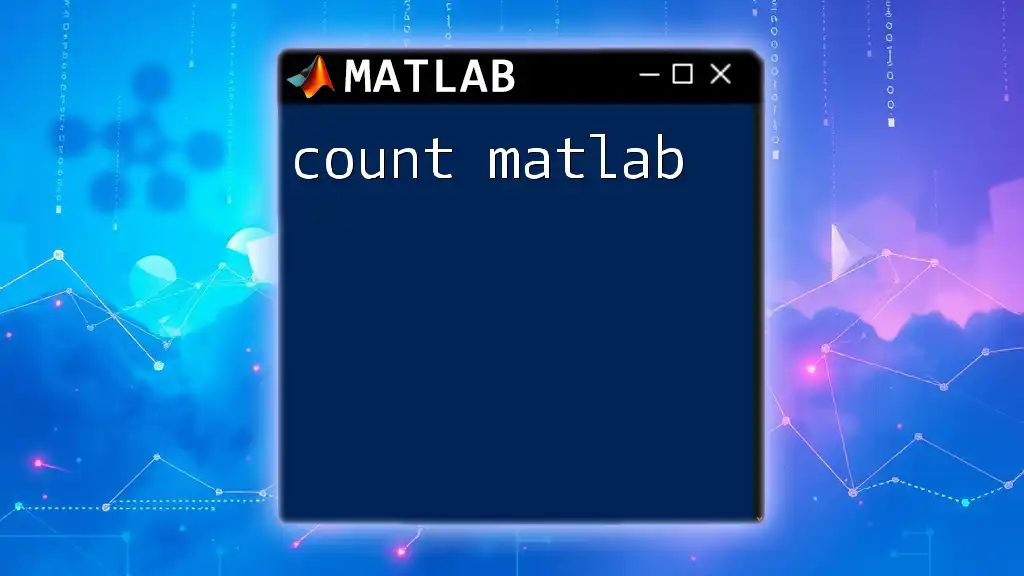The `conj` function in MATLAB computes the complex conjugate of a given complex number or matrix, effectively flipping the sign of the imaginary part.
Here's a code snippet demonstrating its use:
% Example of using conj in MATLAB
z = 2 + 3i; % Define a complex number
conjugate_z = conj(z); % Compute its complex conjugate
disp(conjugate_z); % Display the result
Overview of `conj` Function
What is the `conj` Function?
The `conj` function in MATLAB is crucial for dealing with complex numbers, a fundamental component in various fields including mathematics, physics, and engineering. The complex conjugate of a number is obtained by flipping the sign of its imaginary part. For example, if you have a complex number z = a + bi, its conjugate will be conj(z) = a - bi.
Purpose and Usage of `conj`
The `conj` function serves an important purpose: to compute the complex conjugate of one or more complex numbers. This is particularly useful in many applications, such as simplifying expressions in signal processing and computing power in AC circuits, where we often work with complex representations of sinusoidal signals.

Understanding Complex Numbers in MATLAB
Definition of Complex Numbers
A complex number is defined as a number that can be expressed in the form a + bi, where a is the real part, b is the imaginary part, and i is the imaginary unit, satisfying i² = -1. Complex numbers enable us to handle a broader range of mathematical problems, particularly in systems that cannot be adequately described using only real numbers.
Representing Complex Numbers in MATLAB
In MATLAB, complex numbers can be easily created using the following syntax:
z = 3 + 4i; % Creating a complex number
You can also use the function complex to create complex numbers:
z = complex(3, 4); % Creating a complex number using the complex function
Both methods are effective for representing complex numbers in your code.

Syntax of the `conj` Function
Basic Syntax
The basic syntax for using the `conj` function is straightforward:
y = conj(x)
In this instance:
- x represents the input, which can be a scalar, vector, or matrix of complex numbers.
- y is the output, which will be the complex conjugate of x.
Return Value
When you input a scalar, vector, or matrix of complex numbers, `conj` will return the complex conjugate for each element, maintaining the same shape and dimensions as the input.

Practical Examples of Using `conj`
Example with Scalars
To demonstrate the functionality of `conj` with scalar inputs, consider the following code snippet:
z = 5 + 7i;
conj_z = conj(z);
disp(conj_z); % Outputs 5 - 7i
When conj(z) is executed, it returns 5 - 7i, illustrating how the imaginary part's sign has been flipped.
Example with Vectors
The `conj` function can also be applied to vectors containing complex numbers. Here’s an example:
v = [1 + i, 2 + 2*i, 3 + 3*i];
conj_v = conj(v);
disp(conj_v);
The output will display the conjugates of each component in the vector, showcasing how `conj` operates seamlessly across arrays.
Example with Matrices
For matrices, `conj` works the same way, processing each entry individually:
M = [1+i, 2+2i; 3+3i, 4+4i];
conj_M = conj(M);
disp(conj_M);
The resulting matrix will contain the conjugate values of each complex number from matrix M.

Applications of `conj` in Real-World Scenarios
Signal Processing
In signal processing, the concept of a complex conjugate plays a significant role, especially during Fourier transforms where signals are represented in the frequency domain. Using the `conj` function allows engineers to analyze signal characteristics and compute properties like amplitude and phase shifts.
Example
Here’s how `conj` can be utilized in a simple Fourier Transform computation:
% Example signal
fs = 1000; % Sampling frequency
T = 1/fs; % Sampling period
L = 1000; % Length of signal
t = (0:L-1)*T; % Time vector
% Create a sample signal
S = 0.7*sin(2*pi*50*t) + 0.5*sin(2*pi*120*t);
% Compute the Fourier Transform
Y = fft(S);
% Calculate the power spectrum using conj
Power = abs(Y).^2;
fprintf('Power Spectrum: \n');
disp(Power);
Electrical Engineering
In the field of electrical engineering, complex conjugates are used to represent AC signals and analyze circuits. By calculating complex power using the `conj` function, engineers can determine the real and reactive power in electrical systems.
Example
Consider the following calculation for power:
V = 230 + 0*i; % Voltage
I = 5 + 3*i; % Current
P = V * conj(I); % Complex power
disp(P);
The output represents the total complex power, which incorporates both real and reactive components.

Common Errors and Troubleshooting
Potential Pitfalls
While using the `conj` function, one common error is applying it to non-complex numbers. For example, using `conj` on a real number will not yield an error but may confuse results if one expects complex behavior.
Debugging Tips
You can verify if a number is complex using the `isreal` function. For instance:
if isreal(z)
disp('z is real')
else
disp('z is complex')
end
This helps avoid errors when applying complex functions like `conj`.

Conclusion
Understanding the `conj` function in MATLAB is essential for anyone working with complex numbers. It simplifies calculations in a variety of applications, from signal processing to electrical engineering. Practicing with `conj` will deepen your understanding of complex arithmetic, thus enhancing your MATLAB skills.

Additional Resources
To further your understanding of `conj matlab`, refer to the official MATLAB documentation, where you will find detailed information on complex numbers and other related functions. Additionally, joining forums or online communities can provide valuable insights and answers to your queries. Engaging with other learners and experts can significantly enhance your experience as you dive deeper into the MATLAB programming environment.

















